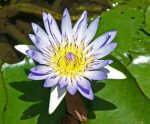 A member of the water lily family, Nymphaeaceae, this tropical aquatic perennial goes by many names including Egyptian lotus, blue water lily, Cape water lily, frog’s pulpit, and sacred lily of the Nile. It is native to parts of the Middle East, North Africa along the Nile, parts of eastern and southern Africa, and some of the nearby islands where it grows in freshwater lakes, pools and rivers. The plant grows from a tuberous rhizome and has long spongy green petioles bearing peltate leaves that are 3-17″ long and may float or lie submerged under the surface of the water. The underside has a conspicuous midrib with lateral veins on each side. The fragrant flowers are 3-5″ across and appear in mid- to late summer on the surface of the water opening from mid morning until dusk for about 4 days. Each flower consists of a central cluster of 100-200 stamens surrounded by 14-20 oblong petals that may be blue, white, mauve, or pinkish, and 4 green sepals. The fruit is a round flattened berry containing seeds with a fleshy bell shaped aril. Photo Credit Wikipedia Commons
A member of the water lily family, Nymphaeaceae, this tropical aquatic perennial goes by many names including Egyptian lotus, blue water lily, Cape water lily, frog’s pulpit, and sacred lily of the Nile. It is native to parts of the Middle East, North Africa along the Nile, parts of eastern and southern Africa, and some of the nearby islands where it grows in freshwater lakes, pools and rivers. The plant grows from a tuberous rhizome and has long spongy green petioles bearing peltate leaves that are 3-17″ long and may float or lie submerged under the surface of the water. The underside has a conspicuous midrib with lateral veins on each side. The fragrant flowers are 3-5″ across and appear in mid- to late summer on the surface of the water opening from mid morning until dusk for about 4 days. Each flower consists of a central cluster of 100-200 stamens surrounded by 14-20 oblong petals that may be blue, white, mauve, or pinkish, and 4 green sepals. The fruit is a round flattened berry containing seeds with a fleshy bell shaped aril. Photo Credit Wikipedia Commons
The blue lotus has been grown since ancient Egyptian times when it was used in burial rites, for making votives, and as an ornament in garden ponds. It was associated with the origin of life in Egyptian mythology and is frequently shown along with the white lotus in stone carvings. Its mild sedative qualities suggest that it might have been the fruit of the lotus tree mentioned in Homer’s Odyssey. Authorities believe that the blue lotus may have been the plant meant by the Hebrew word shushan and translated as lily but alternative plants include Nymphae lotus (white/Egyptian lotus) and Nymphae alba (white water lily
I Kings 7 ( NIV) The furnishings of Solomon’s temple are described.
19. “The capitals on top of the pillars in the portico were in the shape of lilies, four cubits high.”
22. “The capitals on top were in the shape of lilies. And so the work on the pillars was completed.”
26. “It was a handbreadth in thickness, and its rim was like the rim of a cup, like a lily blossom. It held two thousand baths.”
II Chronicles 4:5 (NIV) The huge washing basin in Solomon’s temple is described.
“It was a handbreadth in thickness, and its rim was like the rim of a cup, like a lily blossom. It held three thousand baths.”
Blue lotus likes full sun to part shade and still or slow moving fresh water in USDA Hardiness Zones 10-12. It needs protection from wind and temperatures below 70 degrees. Plants are generally healthy but can suffer damage from aphids and leaf mining midges. Propagation is by seed and division of rhizomes. The rhizomes are edible. Plants are associated with the snail that carries the pathogen for human schistosomiasis.
The genus name, Nymphacea, comes from the Greek word numphaios and means sacred to the nymphs. The specific epithet, caerulea, is the Latin word meaning blue.